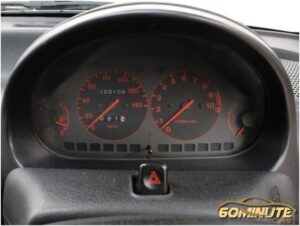japanese cars model: Vivio
The Subaru Vivio is a kei car that was introduced in March 1992, and manufactured by Subaru until October 1998. It has a 658 cc (52 PS) multi-point fuel-injected four-cylinder engine (44 PS DIN was claimed in Europe for the same engine), which is small enough to place it in the kei car class, giving its owners large tax breaks in Japan. There was also a carbureted version with 42 PS (31 kW; 41 hp) in Japan, which equipped the Vivio Van version. The Vivio has impressive interior room considering its small size, thanks to a relatively tall profile and large windows. It is one of the lightest kei cars, weighing in at between 650 kg (1,433 lb) and 700 kg (1,543 lb) depending on the trim line.
The name “Vivio” is a reference to the engine’s displacement of 660 written in Roman numerals (VI, VI, O), and also inspired by the word “vivid”. It replaced the Rex nameplate that was introduced in the 1970s, and was itself superseded by the Subaru Pleo. It was available in 3 and 5-door versions, with a two-door targa top version named T-top being available for special order from 1994. The T-top was built by Takada Kogyo, a convertible specialist who also assembled Nissan’s Figaro and Silvia Varietta amongst other specialty cars.
In November 1995 the Vivio Bistro was introduced. This was a modified version with a retro theme, with Mini-esque front and rear fascias, matching upholstery and modifications to the dashboard. The Bistro series became a hit, causing Subaru to release multiple succeeding versions of the Bistro, called the “Bistro B-Custom”, the “Bistro Chiffon”, the “Bistro White Edition”, the “L Bistro”, the “Sports Bistro” with BBS wheels, the “Bistro SS” using the engine package from the Vivio RX-SS, and the “Club Bistro” with a British black cab appearance. The trend of retro-styled cars was quite popular in 1990s Japan, following the success of Nissan’s “Pike” series cars like the Pao and Figaro. Subaru also tried this approach with the larger Subaru Impreza in a trim called the Casa Blanca with limited success.
The Vivio was available with a variety of normally aspirated or supercharged four-cylinder engines with different gearbox options (including ECVT – an electronically controlled continuously variable transmission) and multiple trim packages. Aside from the top of the line RX-R, all engines were SOHC 8-valve designs. The ECVT equipped supercharged model claimed 64 PS (47 kW; 63 hp) with such a setup, and while the Twin Cam 16-valve RX-R version claimed to make no more power than the SOHC, this was only to stay within the limitations laid down by Japan’s kei car legislations. Claimed torque was higher, at 88 N⋅m (65 lb⋅ft) versus 84 N⋅m (62 lb⋅ft). Front- or four-wheel drive version were offered.
The suspension setup used was inspired by the Legacy, a setup that avoided strictly using MacPherson struts to save on production costs.



